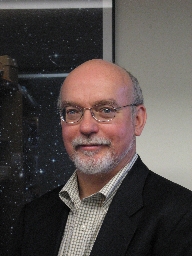Professor John P. Huchra
John P. Huchra, Ph.D., Hon M.A., FAPS, FAAAS is
President of the American Astronomical Society and
the Robert O. & Holly Thomis Doyle Professor of Cosmology and the Senior
Advisor to the Provost for Research Policy at Harvard University and the
Harvard-Smithsonian Center for Astrophysics.
His research interests include the study of the Large-Scale Structure in
the
Universe, the general study of Observational Cosmology including the
determination of the expansion rate, age, and fate of the Universe,
observations of Active Galactic Nuclei (AGN), and galactic evolution,
particularly star formation in galaxies and globular star cluster
systems surrounding other galaxies.
In the early 1980s John worked on the Tully-Fisher relation, which
links the intrinsic luminosity of a spiral galaxy with the rotational
velocity of its stars. He found that with regard to galaxies in the Coma
cluster there was a departure of up to 20% from the supposed
correlation.
He went on in 1982 with a number of
colleagues to apply
the relation to the Local Group of galaxies to see if the peculiar
motion tentatively identified by Vera Rubin could be detected. The
peculiar velocities of several hundred galaxies in the region of the
Virgo cluster were measured. He found that velocities in the direction
of Virgo steadily increased, while decreasing on the other side. The
result has been interpreted by some as evidence for the existence of The
Great Attractor, a proposed massive concentration of galaxies lying
beyond the Hydra-Centaurus supercluster.
In 1986 in collaboration with Margaret Geller, John began a galactic
survey for the Smithsonian Center for Astrophysics (CfA). He used a
1.5-meter telescope located on Mount Hopkins, Tucson, Arizona and sought
to measure the red shifts of galaxies below a magnitude of 15.5 and
falling within a wedge of sky 6° wide, 120° long, and out to a
distance
of about 300 million light years. By 1989 he had mapped the positions
of 10,000 galaxies.
To his surprise, instead of producing a uniform distribution his
maps revealed large voids within which huge clusters of galaxies were
distributed. The largest structure he observed, dubbed The Great Wall,
stretched 500 million light years without its edge being
found.
John coauthored
Optical Spectroscopy of Type Ia Supernovae,
2MTF I. The Tully-Fisher Relation in the 2MASS J, H, and K
Bands,
The reddest ISO-2MASS quasar,
Narrow-line AGN in the ISO-2MASS Survey,
The XMM-Newton wide-field survey in the COSMOS field: III. optical
identification and multiwavelength properties of a large sample of X-ray
selected sources,
Groups of Galaxies in the Two Micron All-Sky Redshift Survey,
Dusty waves on a starry sea: the mid-infrared view of M31,
Magellan Spectroscopy of AGN Candidates in the COSMOS Field,
Hubble Space Telescope Observations of Star Clusters in M101,
and
The ROSAT North Ecliptic Pole Survey: The X-ray Catalog.
Read the
full list of his publications!
John earned his B.S. in Physics at the Massachusetts Institute of
Technology (MIT) in 1970 and his Ph.D. in Astronomy at the California
Institute of Technology (Caltech) in 1976. He received an honorary M.A.
at Harvard University in 2005. He was elected a Fellow of the American
Physical Society in 1991 and a Fellow of the American Association for
the Advancement of Science in 1994.





